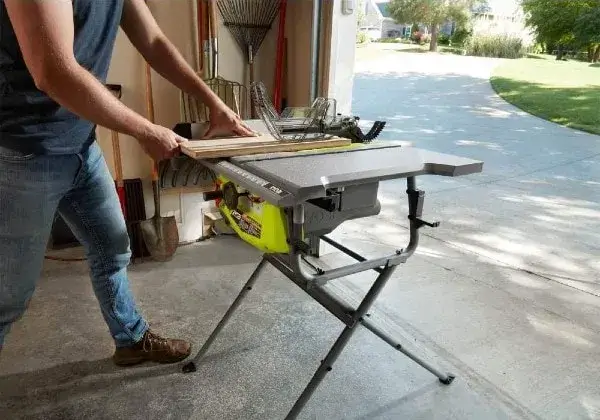If you are a woodworker, you probably know that there are different types of saws and blades for cutting wood. But do you know the difference between rip cut and cross cut table saw? In this article, we will explain what these terms mean, how they affect the quality and speed of your cuts, and what kind of blades you should use for each type of cut.
Rip Cut vs Cross Cut: The Basic Difference
The main difference between rip cut and cross cut table saw is the direction of the cut relative to the grain of the wood. Rip cut table saw cuts along the grain, while cross cut table saw cuts across the grain. This has implications for the ease, accuracy, and smoothness of the cut, as well as the type of blade you should use.
Why Does the Direction of the Cut Matter?
Wood is composed of fibers that run in a certain direction, called the grain. The grain affects the strength, appearance, and workability of the wood. When you cut wood, you are either cutting with the grain or against the grain, and this affects how the wood reacts to the blade.
Rip Cut Table Saw
When you rip cut wood, you are cutting along the grain, parallel to the fibers. This means that you are splitting the wood fibers apart, rather than cutting through them. This makes the cut easier and faster, but also more prone to splintering and burning. To prevent these problems, you need a blade that has fewer teeth, larger gullets, and a lower hook angle. These features allow the blade to remove more material per tooth, clear the chips faster, and reduce the friction and heat.
A rip cut table saw blade typically has 24 to 40 teeth, depending on the thickness of the wood. The gullets are the spaces between the teeth, and they are usually deep and wide to accommodate the large chips. The hook angle is the angle of the tooth face relative to the centerline of the blade. A lower hook angle (10 to 15 degrees) means that the teeth are more perpendicular to the blade, which reduces the tendency of the blade to pull the wood into the cut.
A rip cut table saw is ideal for cutting thick and hard wood, such as hardwoods, plywood, and MDF. It is also useful for cutting wood into narrower pieces, such as strips, planks, and boards.
Cross Cut Table Saw
When you cross cut wood, you are cutting across the grain, perpendicular to the fibers. This means that you are cutting through the wood fibers, rather than splitting them apart. This makes the cut more difficult and slower, but also more precise and smooth. To achieve these results, you need a blade that has more teeth, smaller gullets, and a higher hook angle. These features allow the blade to make finer cuts, reduce the tear-out, and improve the feed rate.
A cross cut table saw blade typically has 60 to 80 teeth, depending on the smoothness of the cut. The gullets are the spaces between the teeth, and they are usually shallow and narrow to minimize the gap between the teeth. The hook angle is the angle of the tooth face relative to the centerline of the blade. A higher hook angle (20 to 25 degrees) means that the teeth are more angled to the blade, which increases the aggressiveness of the cut and the speed of the feed.
A cross cut table saw is ideal for cutting thin and soft wood, such as pine, cedar, and poplar. It is also useful for cutting wood into shorter pieces, such as squares, rectangles, and angles.
How to Choose the Right Blade for Your Cut
As you can see, rip cut and cross cut table saw blades are designed for different purposes and have different characteristics. Therefore, you should choose the right blade for your cut, depending on the type, size, and quality of the wood, and the desired outcome of the cut.
If you are only making rip cuts or cross cuts, you can use a dedicated blade for each type of cut. However, if you are making both types of cuts, or you want a more versatile blade, you can use a combination blade. A combination blade is a compromise between a rip cut and a cross cut blade, and it has features of both. A combination blade typically has 40 to 50 teeth, medium-sized gullets, and a moderate hook angle. It can perform both rip cuts and cross cuts reasonably well, but not as well as a dedicated blade.
Another option is to use a specialty blade, such as a dado blade, a thin-kerf blade, or a carbide-tipped blade. A dado blade is a stack of blades that can cut grooves, slots, and dadoes in wood. A thin-kerf blade is a blade that has a thinner width than a standard blade, which reduces the waste and the power required. A carbide-tipped blade is a blade that has teeth made of carbide, a hard and durable material that can last longer and cut cleaner than steel.
Conclusion
Rip cut and cross cut table saw are two different types of cuts that you can make on wood, depending on the direction of the cut relative to the grain of the wood. Rip cut table saw cuts along the grain, while cross cut table saw cuts across the grain. Each type of cut has its advantages and disadvantages, and requires a different type of blade. You should choose the right blade for your cut, based on the characteristics of the wood and the desired outcome of the cut. By doing so, you can improve the quality and efficiency of your woodworking projects.

